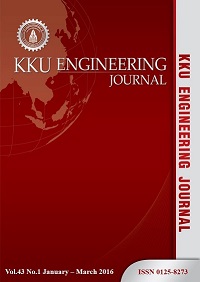Structural comparison of anodic nanoporous-titania fabricated from single-step and three-step of anodization using a two parallel electrode anodizing cell
Main Article Content
Abstract
Anodization of a Ti sheet in an ethylene glycol electrolyte containing 0.38wt% NH4F with the addition of 1.79wt% H2O at room temperature was studied. An applied potential of 10-60 V and anodizing time of 1-3 h were used in a single-step and three-step of anodization within a two parallel electrode anodizing cell. Their structural and textural properties were investigated using X-ray diffraction (XRD) and scanning electron microscopy (SEM). After annealing at 600°C in an air furnace for 3 h, TiO2-nanotubes was transformed so that they had a higher proportion of the anatase crystal phase. Also, crystallization of the anatase phase was enhanced as the duration of anodization during the final step was increased. Using a single-step anodization, the pore texture of the oxide film began to appear at an applied potential of 30 V. Increased orderly arrangement of the TiO2-nanotube array with a larger pore size was obtained with increased applied potential. An applied potential of 60 V was selected for the three-step anodization with anodizing times of 1-3 h. The results showed that a smooth surface coverage with a higher density porous-TiO2 layer was achieved using prolonging times during the first and second steps. However, discontinuity of tubes in length was produced instead of long-vertical tubes. Layer thickness of the anodic oxide film depended on the anodizing time at the last step of anodization. Better arrangement of nanostructured-TiO2 was produced using a three-step anodization process at 60 V with 3 h for each step.
Article Details
This work is licensed under a Creative Commons Attribution-NonCommercial-NoDerivatives 4.0 International License.



